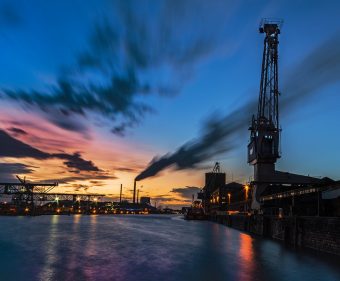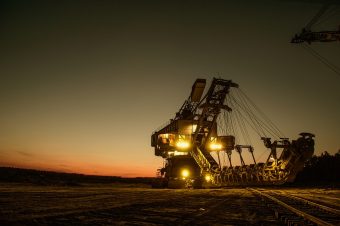The Rocky Mountain Institute recently released a report titled Decarbonization Pathways for Mines: A Headlamp in the Darkness, in which it was stated that in 2015, half of worldwide industrial greenhouse gas emissions came from 50 companies working in fossil-fuel industries. (This statement was a reference to a previously published report from the Carbon Disclosure Project.) RMI’s new document states many mining companies are among the top greenhouse gas emitters. Thomas Kirk and Jessie Lund from RMI answered some questions about the report for CleanTechnica.

1. In 2015, according to the report, half of worldwide industrial greenhouse gas emissions could be traced back to just 50 companies working in heavy fossil-fuel industries. How can those companies reduce their carbon emissions?
Companies can reduce their emissions through a couple of steps. First, they need to assess and understand where emissions are occurring in their operations, set up processes to track and measure their progress and then begin implementing changes & new technologies. At the broadest possible level this means operate as efficiently as possible and electrify everything remaining. And of course they should ensure that their electricity is being generated by renewable sources. The tricky part for the carbon majors is that the majority of their emissions are indirect “Scope 3 emissions” that occur downstream from their operations.
2. Why would they be motivated to reduce them?
If there’s one thing these companies understand, it’s risk. And these emissions represent significant risks related to both the transition to a lower-carbon economy and the physical impacts of climate change. Transition risks include policy, legal, technology, and market changes. For example, countries are beginning to pass carbon prices that will dramatically impact these companies. If carbon pricing policies are the “stick,” companies must also be cognizant of “carrot” policies, such as those offering incentives for shifting energy sources to lower-carbon fuels and technologies like solar and wind. Both types of policies may pose a significant threat to companies whose business relies primarily on the extraction of carbon-intensive resources like coal, for which we expect to see a sharp decline in demand. Transition risk can also include reputation risk, as companies face more public scrutiny and pressure as the effects of climate change become more pronounced. Mining companies in particular must satisfy community demands in order to secure the essential “social license to operate.” Mines tend to operate in more remote locations and often need to transport their products long distances, making them especially vulnerable to the physical risks resulting from climate change, such as those driven by more frequent and more severe extreme weather events like hurricanes, floods, and wildfires. These risks include both direct damage to assets and indirect impacts from supply chain disruption, both of which have financial implications for companies.
In addition to mitigating the risks mentioned above, companies are also motivated to reduce their emissions by the opportunities that these reductions present. For example, increases in efficiency frequently result in cost savings. With the cost of renewable energy coming down, electrification and renewables development are also often smart financial decisions. Plus, a company that reduces its Scope 3 emissions by divesting its assets from coal (as Rio Tinto recently did) is then able to focus its operations on supplying the minerals necessary for the energy transition (i.e. those used in batteries, solar panels, electric vehicles, etc.), for which we expect the market demand to increase.
3. Do these fossil fuel companies work overtly or behind the scenes to influence public policy in their own favor?
I don’t know of any company or industry that doesn’t lobby for itself, but I won’t speculate on what practices they engage in or their effectiveness without solid evidence or data.
4. Can mining companies be trusted to accurately report their own carbon emissions?
Mining companies often report through CDP (formerly the Carbon Disclosure Project), which requires verification through an accepted standard. Beyond this, there simply isn’t an economic incentive for most mining companies to report false emissions data at this point. In the event of widespread carbon pricing or taxation linked to successfully tracking decarbonization goals there would be an economic incentive, but also a clear pool of money to pay third party auditors.

5. What technologies could mining companies use to reduce their carbon emissions?
Mining companies have a wide array of technologies they can deploy to reduce carbon emissions. First, they can deploy technologies that make them more efficient and productive such as advanced fragmentation and drilling, asset management using IOT devices, variable-frequency drives, LEDs and new smelting and refining techniques. Next, the mine could seek out opportunities for beneficial electrification. Along with their environmental benefits, electric motors tend to be more emissions-efficient, quieter, emit no particulate matter and require less maintenance than similar diesel-powered machines. Once the mine’s energy loads have been optimized through efficiency and electrification, then the mine should focus on greening their electricity supply through renewable power generation and lower-emissions generation (natural gas before diesel) as necessary.
6. Are some mining companies investing in onsite solar and energy storage in the field so they can reduce their dependence on diesel generators?
Mining companies have been installing solar for several years now to displace costly diesel generation. Energy storage is far less common, but there are several examples and more expected as the price continues to drop. RMI tracks all public renewable power resources at mines here.
7. Have mining companies been historically resistant or slow to adopt carbon-reducing measures?
Mining companies, especially the larger players, have adopted carbon-reduction measures in a timely manner, but they have been resistant to setting targets and goals that are in line with the Paris Agreement. To date, no mining company has a Science Based Target Initiative approved target.
8. Coal appears to be on the ropes due to the decreasing costs of new solar and wind power. Is it only a matter of time before all the current coal power plants are phased out because no new ones will be built?
Currently there is a strong trend of decreasing coal generation, especially in developed nations. Eventually, yes, I expect all current coal power plants to be phased out, but it will likely occur before age forces all the existing coal plants into retirement. First, coal plants will continue to face more stringent regulations and policies regarding their emissions, both CO2 and particulate matter. Complying with these regulatory changes will increase operating costs while alternative generation sources, particularly wind and solar but also natural gas will likely decrease in cost. Once the operating costs of a coal plant are greater than building an entirely new renewable or gas-fired plant, the coal plant should be forced off-line by the PUC on behalf of the rate-payers.
9. Will there be some kind of support or government assistance programs for areas with coal mining for the people who worked in mining companies who won’t be able to continue when their jobs are phased out?
The US government already has various job retraining programs, but I can’t say if there will be specific programs to coal miners either here or globally. For perspective, there around 50,000 coal mining jobs in the US, while there are 3.5 million US truck drivers who could also become unemployed as self-driving technology develops. On the other hand, there are nearly 3.2 million clean energy jobs, including solar, wind, energy efficiency, and clean vehicles, in the US, with job growth expected to rise. In fact, wind technicians and solar installers are predicted to be the two fastest-growing jobs from 2016 to 2026. Solar alone already employs nearby four times the number of coal generation workers. So yes, it would be an extremely good idea for the US and other governments to set aside funding for re-training and assistance programs.
While RMI’s work does not focus on retraining or assistance programs for former coal miners, we do collaborate with fellow nonprofits like the Just Transition Fund who are working to help communities and governments prepare for the inevitable closing of more coal plants and coal mines and ensure that these communities are not left behind in the energy transition, but rather that they are able to build strong, resilient, and diversified new energy economies.
Source: Clean Technica


